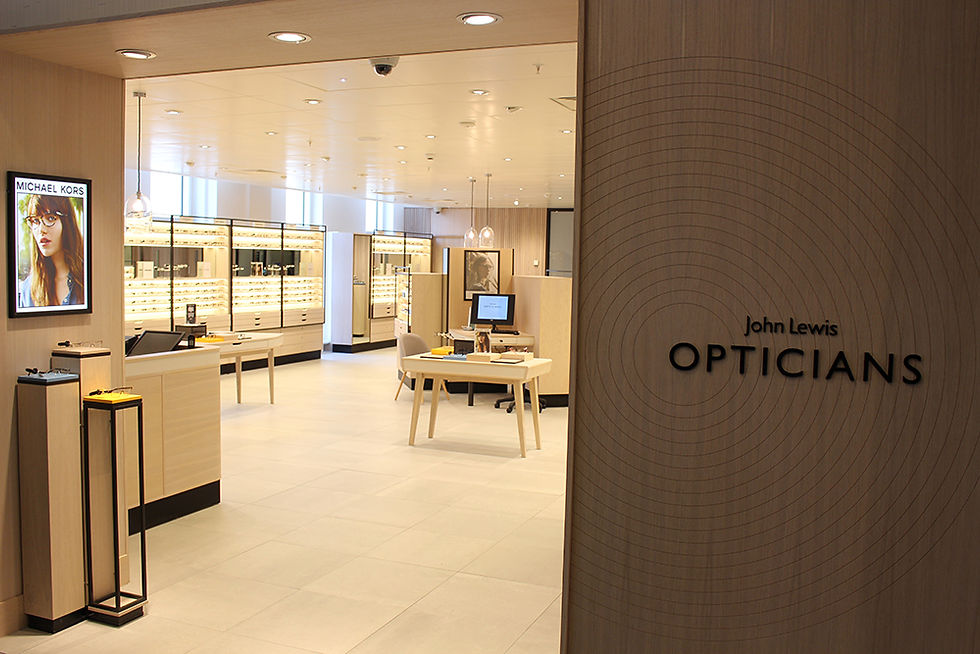In the frame – stores drive sales in eyewear retail
- Rebecca

- Jan 29, 2024
- 3 min read
Updated: Feb 6, 2024
Next month sees the return of the trade show 100% Optical at ExCel London. Widely regarded as essential ‘healthcare’ spend, the optical goods retail market initially made a strong recovery post-pandemic. According to Mintel’s market analysis, in 2022 the pent-up demand for eye appointments and updated prescriptions fuelled growth, with over 90% of eyewear shoppers buying their prescription glasses in-store rather than online.
However, looking back at 2023, Mintel’s latest analysis reveals that opticians and the UK eyewear industry are not immune to the challenges of the current economic climate. Consumers are forgoing eye test appointments and purchases while finances are under pressure. In fact, Mintel found that a quarter of consumers had postponed eye tests as a direct result of the cost-of-living crisis.
In-store purchasing remains essential
In their report, Mintel looks at the challenges facing the UK optical goods retailing sector and explores some of the opportunities. One that grabbed our attention is that in-store purchasing remains essential to driving growth. They report that despite the developments in online optical retail – such as AI-driven style recommendations and free at-home trials of frames - the digital channel has not yet evolved to surpass the physical shopping experience for eyewear shoppers.
Consumers continue to prefer physical retail and the reassurance they get from visiting a ‘trusted’ optician known for their expertise and customer service. In fact they place a huge importance on this, with 57% saying this is a key factor when choosing an optician.
In addition to high street eyewear retail, luxury sunglasses continue to fuel consumer footfall in the travel retail sector. In this month’s DFNI travel retail magazine, they discuss the strength of the sunglasses category and the importance of the physical store space for fashion-conscious customers, particularly Millennials (who are travelling more frequently post-pandemic).
Insights for eyewear store success
So, if eyewear stores are going to remain vital for driving growth this year, it seems like a good time to share some of our insights, gleaned from over a decade of designing stores for global optical and sunglass brands.
As a guiding principle we put customers at the centre of the store ‘experience’. It’s the same for all our shop design projects, regardless of the sector. We help retailers recognise and understand what customers want from their visit, then design the elements that will support the delivery of shoppers’ needs.
The store layout should support customer flow. The journey from the shop window to consultation, to testing, and then to choosing a frame must feel smooth and logical. Customers need to be able to circulate easily, browse frames, and find sufficient waiting and private consultation zones without experiencing bottlenecks.
Focus on choice. This is a big one for eyewear shoppers and should be expressed through attractive display, with trending frames and offers being given centre stage. Pay close attention also to lighting schemes from the shop window and throughout the store to enhance display and consultation zones.
Support personal service. We know that personal service is a priority for this sector, so the store layout needs to support and encourage engagement between customers and staff. Avoid physical barriers where possible, for instance, tablets and portable payment tech allow for removal of traditional cash desks. The comfort of the ‘individual’ is paramount to help customers relax and increase their dwell time. Therefore, seating areas and consultation desks need to be comfortable and take account of privacy.
Materiality must meet and beat expectations. The store design and specifications need to reflect the value of the products on offer as well as the aspirations of the target customer. For instance, budget and mid-market chains can express value for money through a clean, simple, more clinical look. Whereas higher priced brands need to channel a more luxury fashion feel.
Reinforce expertise. This is another critical deliverable, as flagged by Mintel’s research. The unique brand stories that achieve traction in the digital marketing sphere should be brought to life and made tangible in-store. Look beyond service to express professionalism and competency through physical elements. Contemporary fitouts with clean organised displays, instore graphics that signpost expert services, state-of the-art eye test equipment and modern IT, all these things express ‘competency’ and matter greatly to customers.
Consumers in the market for new eyewear this year are going to be more discerning than ever about where to spend their tighter budgets. So, we’re looking forward to networking at 100% Optical and discussing our ideas for investing in bricks-and-mortar to attract footfall and support ongoing customer loyalty in those all-important stores.
Lighting supports a unique display for David Clulow at Harrods

Meeting and beating customer expectations at John Lewis Opticians
Fashion focused standout store for Sunglass Hut
Drawing the crowds in a bustling airport for Oakley



Comments